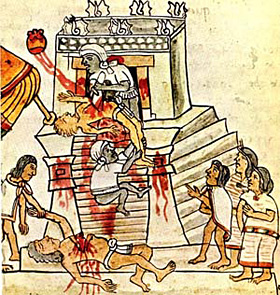 |
 |
 |
 News Around the Republic of Mexico | April 2007 News Around the Republic of Mexico | April 2007  
Ancient Mexicans Took Sacrifice Victims from Afar
 Reuters Reuters


| | Aztec human sacrifice, from Codex Magliabechiano, a post-conquest document. |
Ancient Mexicans brought human sacrifice victims from hundreds of miles (km) away over centuries to sanctify a pyramid in the oldest city in North America, an archeologist said on Wednesday.

DNA tests on the skeletons of more than 50 victims discovered in 2004 in the Pyramid of the Moon at the Teotihuacan ruins revealed they were from far away Mayan, Pacific or Atlantic coastal cultures.

The bodies, many of which were decapitated, dated from between 50 AD and 500 AD and were killed at different times to dedicate new stages of construction of the pyramid just north of Mexico City.

The victims were likely either captured in war or obtained through some kind of diplomacy, said archeologist Ruben Cabrera, who led the excavation at the pyramid, the smaller of two main pyramids are Teotihuacan, which housed some 200,000 inhabitants at its height of power around 500 AD.

"Teotihuacan may have had a tradition of capturing prisoners for sacrifice," said Cabrera.

Ancient Mexican civilizations like the Aztecs sacrificed humans by cutting their hearts out but researchers are not sure how the victims at Teotihuacan were killed.

Little is known about the race that inhabited Teotihuacan or what language they spoke.

The site, Mexico's oldest major archeological site, was revered by later Mesoamerican civilizations, including the Aztecs, who gave it its current name, meaning "The place where gods are made" in their Nahuatl language.

Teotihuacan icons found in far away Mayan ruins in Guatemala and Honduras show the city's broad reach.

Littered among the victims' bodies at the pyramid are remains of animals that had symbolic importance including pumas, coyotes, eagles and snakes as well as a large number of precious objects like obsidian knives.

Discoveries in the early 1980s of sacrificial victims and weapons skewered previous theories that Teotihuacan had a peaceful culture, unlike the warlike Aztecs and Maya.

"Researchers always tried to throw a little fog over it, but there was human sacrifice even if we don't know if it had to do with wars," said Cabrera. | 
 | |
 |



